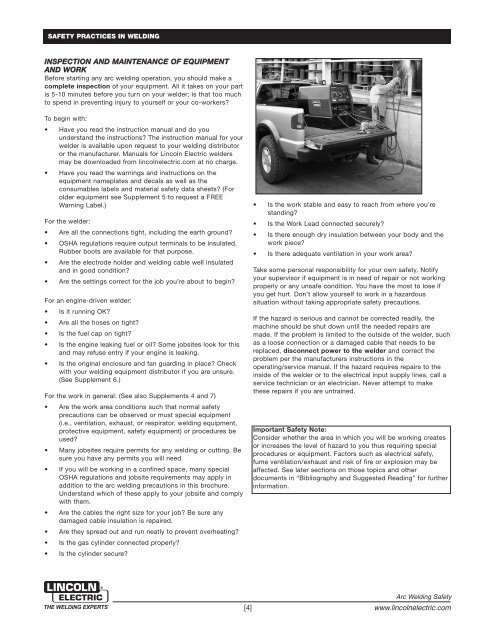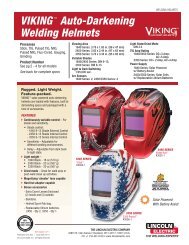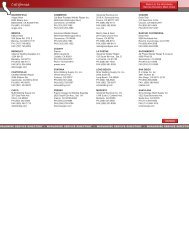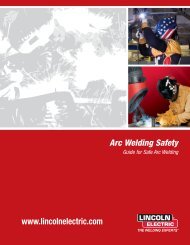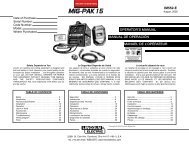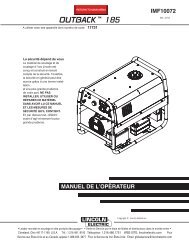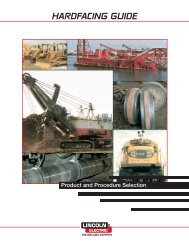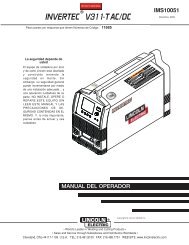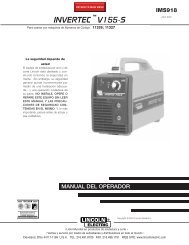E205 Arc Welding Safety - Lincoln Electric
E205 Arc Welding Safety - Lincoln Electric
E205 Arc Welding Safety - Lincoln Electric
Create successful ePaper yourself
Turn your PDF publications into a flip-book with our unique Google optimized e-Paper software.
SAFETY PRACTICES IN WELDING<br />
INSPECTION AND MAINTENANCE OF EQUIPMENT<br />
AND WORK<br />
Before starting any arc welding operation, you should make a<br />
complete inspection of your equipment. All it takes on your part<br />
is 5-10 minutes before you turn on your welder; is that too much<br />
to spend in preventing injury to yourself or your co-workers?<br />
To begin with:<br />
• Have you read the instruction manual and do you<br />
understand the instructions? The instruction manual for your<br />
welder is available upon request to your welding distributor<br />
or the manufacturer. Manuals for <strong>Lincoln</strong> <strong>Electric</strong> welders<br />
may be downloaded from lincolnelectric.com at no charge.<br />
• Have you read the warnings and instructions on the<br />
equipment nameplates and decals as well as the<br />
consumables labels and material safety data sheets? (For<br />
older equipment see Supplement 5 to request a FREE<br />
Warning Label.)<br />
For the welder:<br />
• Are all the connections tight, including the earth ground?<br />
• OSHA regulations require output terminals to be insulated.<br />
Rubber boots are available for that purpose.<br />
• Are the electrode holder and welding cable well insulated<br />
and in good condition?<br />
• Are the settings correct for the job you’re about to begin?<br />
For an engine-driven welder:<br />
• Is it running OK?<br />
• Are all the hoses on tight?<br />
• Is the fuel cap on tight?<br />
• Is the engine leaking fuel or oil? Some jobsites look for this<br />
and may refuse entry if your engine is leaking.<br />
• Is the original enclosure and fan guarding in place? Check<br />
with your welding equipment distributor if you are unsure.<br />
(See Supplement 6.)<br />
For the work in general: (See also Supplements 4 and 7)<br />
• Are the work area conditions such that normal safety<br />
precautions can be observed or must special equipment<br />
(i.e., ventilation, exhaust, or respirator, welding equipment,<br />
protective equipment, safety equipment) or procedures be<br />
used?<br />
• Many jobsites require permits for any welding or cutting. Be<br />
sure you have any permits you will need.<br />
• If you will be working in a confined space, many special<br />
OSHA regulations and jobsite requirements may apply in<br />
addition to the arc welding precautions in this brochure.<br />
Understand which of these apply to your jobsite and comply<br />
with them.<br />
• Are the cables the right size for your job? Be sure any<br />
damaged cable insulation is repaired.<br />
• Are they spread out and run neatly to prevent overheating?<br />
• Is the gas cylinder connected properly?<br />
• Is the cylinder secure?<br />
[4]<br />
• Is the work stable and easy to reach from where you’re<br />
standing?<br />
• Is the Work Lead connected securely?<br />
• Is there enough dry insulation between your body and the<br />
work piece?<br />
• Is there adequate ventilation in your work area?<br />
Take some personal responsibility for your own safety. Notify<br />
your supervisor if equipment is in need of repair or not working<br />
properly or any unsafe condition. You have the most to lose if<br />
you get hurt. Don’t allow yourself to work in a hazardous<br />
situation without taking appropriate safety precautions.<br />
If the hazard is serious and cannot be corrected readily, the<br />
machine should be shut down until the needed repairs are<br />
made. If the problem is limited to the outside of the welder, such<br />
as a loose connection or a damaged cable that needs to be<br />
replaced, disconnect power to the welder and correct the<br />
problem per the manufacturers instructions in the<br />
operating/service manual. If the hazard requires repairs to the<br />
inside of the welder or to the electrical input supply lines, call a<br />
service technician or an electrician. Never attempt to make<br />
these repairs if you are untrained.<br />
Important <strong>Safety</strong> Note:<br />
Consider whether the area in which you will be working creates<br />
or increases the level of hazard to you thus requiring special<br />
procedures or equipment. Factors such as electrical safety,<br />
fume ventilation/exhaust and risk of fire or explosion may be<br />
affected. See later sections on those topics and other<br />
documents in “Bibliography and Suggested Reading” for further<br />
information.<br />
<strong>Arc</strong> <strong>Welding</strong> <strong>Safety</strong><br />
www.lincolnelectric.com


